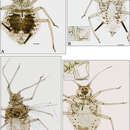Description
provided by Zookeys
Apterous viviparous female(Figs 4A, B). Colour in life unknown. Head yellowish brown with rugosity near the eyes. Antennal segments I-IV as pale as cephalic dorsum, and V and VI darker. Dorsal pigmentation and sclerotisation very variable. In several specimens, holotype included prothorax with complete but pale band, metathorax with brown spinopleural transverse band and setiferous marginal sclerites, abdominal segments 1-6 with an extensive dark spinopleural patch, partially fragmented in midline and with an irregular lateral margin partly incorporating the marginal sclerites; abdominal segments 7 and 8 with bands paler than patch. In other specimens, dorsum mainly membranous, with pale brown to brown pleural sclerites on abdominal segments 1-6, which are irregular in shape and sometimes joined between segments, and several very small and pale marginal setiferous sclerites. Other specimens have an intermediate degree of sclerotisation and pigmentation. Mesosternal mammariform processes yellowish, thin and tall. Siphunculi cylindrical, dark, and densely covered with denticulate scales. Cauda triangular (sometimes with a slight constriction) with pointed apex, and not darker than legs. Anal and genital plates as pale as cauda. Metric and meristic features in Table 3.
Metric and meristic features of Aphidura gallica sp. n. and Aphidura amphorosiphon sp. n.; n, number of measured specimens.
Aphidura gallica Aphidura gallica Aphidura amphoro-siphon Aphidura amphoro-siphon Aphidura amphoro-siphon Apt. viv. femal. Al. viv. femal. Ap. viv. femal. Al. viv. femal. Male n = 30 n = 2 n = 12 n = 3 n = 1 Body [mm] 1.475–2.325 1.600–1.725 1.275–1.638 1.100–1.525 1.275 Antenna [mm] 1.070–1.735 1.343–1.343 0.978–1.170 1.265–1.615 1.340–1.380 Antenna / Body [times] 0.66–0.93 0.84–0.84 0.71–0.89 1.05–1.15 1.05–1.08 Ant. segm. III [mm] 0.32–0.49 0.23–0.36 0.26–0.35 0.35–0.40 0.38–0.38 Ant. segm. IV [mm] 0.16–0.36 0.12–0.22 0.14–0.20 0.20–0.28 0.22–0.23 Ant. segm. V [mm] 0.14–0.26 0.11–0.18 0.13–0.18 0.16–0.23 0.17–0.19 Ant. segm. VI base [mm] 0.08–0.13 0.10–0.10 0.09–0.11 0.10–0.13 0.10–0.11 Ant. segm. VI processus terminali mm] 0.25–0.44 0.37–0.37 0.25–0.31 0.32–0.48 0.37–0.38 Ant. segm. VI processus terminalis/ Ant. segm. III [times] 0.66–0.99 1.04–1.04 0.77–1.07 0.85–1.22 1.00 Ant. segm. VI processus terminalis/ base [times] 2.88–4.08 3.89–3.89 2.57–3.08 3.37–4.04 3.57–3.70 Secondary sensoria, Ant. segm. III [number] 0 16–34 0 16–21 63–72 Secondary sensoria, Ant. segm. IV [number] 0 0 0 0 29–32 Secondary sensoria, Ant. segm. V [number] 0 0 0 0 11–15 Ultimate rostral segm. [mm] 0.11–0.15 0.10–0.13 0.12–0.14 0.10–0.13 0.10 Ultimate rostral segm. / its basal width [times] 2.00–3.00 2.00–2.60 2.18–2.80 2.88–2.88 2.67 Ultimate rostral segm. / Ant. segm. VI base [times] 1.10–1.87 1.37–1.37 1.12–1.42 0.96–1.05 0.95–1.00 Hind femur [mm] 0.39–0.60 0.39–0.50 0.35–0.46 0.38–0.45 0.42–0.43 Hind tibia [mm] 0.72–1.13 0.81–1.02 0.61–0.83 0.80–1.00 0.82–0.85 Hind tibia / Body [times] 0.43–0.59 0.51–0.59 0.45-0.55 0.58–0.73 0.64–0.67 Hind tarsus, 2nd segm. [mm] 0.10–0.12 0.11–0.11 0.08–0.10 0.10–0.11 0.09–0.10 Hind tarsus, 2nd segm. / Ultimate rostral segm. [times] 0.70–0.95 0.81–1.05 0.67–0.83 0.83–0.95 0.90–0.95 Abdominal marginal papillae [number] 0 0 0 0 0 Siphunculus [mm] 0.35–0.50 0.35–0.42 0.27–0.33 0.25–0.30 0.24 Siphundulus / Body [times] 0.20–0.29 0.22–0.24 0.18–0.24 0.18–0.24 0.19 Siphunculus / Ant. segm. III [times] 0.87–1.24 0.99–1.84 0.90–1.04 0.65–0.77 0.64–0.65 Siphunculus / its basal width [times] 4.00–5.57 7.00–7.00 3.60–5.80 3.85–5.89 5.33 Siphuncular widths, maximal / basal [times] 0.50–0.86 0.80–0.80 0.83–1.20 0.81–1.11 1.33 Siphuncular widths, maximal / minimal [times] 1.00–1.00 1.00–1.00 1.25–1.79 1.47–2.00 2.18 Siphuncular minimal width / Hind tibia, diameter at middle [times] 1.05–1.57 1.33–1.69 1.00–1.57 1.00-0.50 0.61 Cauda [mm] 0.15–0.24 0.15–0.19 0.14–0.19 0.09–0.15 0.09 Cauda / Siphunculus [times] 0.36–0.50 0.41–0.46 0.45–0.62 0.34–0.50 0.38 Cauda / its basal width [times] 1.07–1.32 1.12–1.36 1.10–1.46 0.86–1.45 0.78 Setae on … … Frons [μm] 26–45 23–23 17–38 15–21 10 … Frons / b. d. Ant. segm. III [times] 1.2–2.3 1.6–1.6 1.0–1.9 0.8–1.2 0.5 … Vertex [μm] 23–35 18–18 10–23 15–20 13 … Vertex / b. d. Ant. segm. III [times] 1.00–1.75 1.3–1.3 0.6–1.3 0.8–1.1 0.7 … Ant. segm. III [μm] 13–25 15–20 7–13 7–10 5 … Ant. segm III / T. Ant. segm. III [times] 0.6–1.3 0.7–1.5 0.5–0.7 0.4–0.6 0.3 … Ultimate rostral segm. [number] 10–16 11–11 11–17 9–13 12 … Hind femur, dorsal [μm] 13–25 13–20 7–15 10–15 10 … Hind femur, ventral [μm] 23–45 25–28 20–30 17–23 15 … Hind tibia, dorsal, at middle [μm] 25–38 25–28 20–30 20–23 20 … Hind tibia, dorsal / Tibial diameter (at middle) [times] 0.5–1.0 0.8–0.9 0.6–1.0 0.8–0.9 0.6 … Hind tarsus, first segm. [number] 2–3 2–3 2–3 2–3 2–3 … Abdominal segm. 2–4 [μm] 13–23 16–20 7–13 10–13 7 … Abdominal segm. 2–4 / T. Ant. segm. III [times] 0.6–1.1 0.7–1.5 0.4–0.8 0.5–0.6 0.4 … Abdominal segm. 8 [μm] 23–38 23–28 22–33 18–25 23 … Abdominal segm. 8 / T. Ant. segm. III [times] 1.1–2.0 1.2–1.6 1.0–2.0 1.0–1.3 1.1 … Abdominal segm. 8 [number] 4–5 4–4 4–4 4–4 4 … Ventro-abdominal [μm] 25–50 28–33 20–35 25–33 23 … Genital plate, discal [number] 2–4 2–2 2–2 2–2 — … Genital plate, marginal [number] 10–17 10–12 10–16 8–10 — … Cauda [number] 6–9 8–8 6–7 6–6 6
NOTE. Used abbreviations: Al., Alate; Ant., Antennal; Apt., Apterous; b. d., basal diameter; femal., females; n, number of measured specimens; segm., segment; viv., viviparous.
Alate viviparous female(Fig. 4C). Head brown, as dark as thorax. Abdominal segments 1 and 2 with spinal sclerites; segments 4-5 with spinopleural patch, sometimes partially joined with the spinopleural bands on 3 and 6; segments 1-6 with marginal sclerites; segment 7 with a band paler than previously mentioned sclerites; segment 8 with pale setiferous sclerites, sometimes coalesced together. Metric and meristic features in Table 3.
- license
- cc-by-3.0
- copyright
- Juan-Manuel Nieto Nafría, Milagros-Pilar Mier Durante, Georges Remaudière
- bibliographic citation
- Nieto Nafría J, Mier Durante M, Remaudière G (2013) The genus Aphidura (Hemiptera, Aphididae) in the collection of the Muséum national d’Histoire naturelle of Paris, with six new species ZooKeys 318: 1–33
- author
- Juan-Manuel Nieto Nafría
- author
- Milagros-Pilar Mier Durante
- author
- Georges Remaudière

